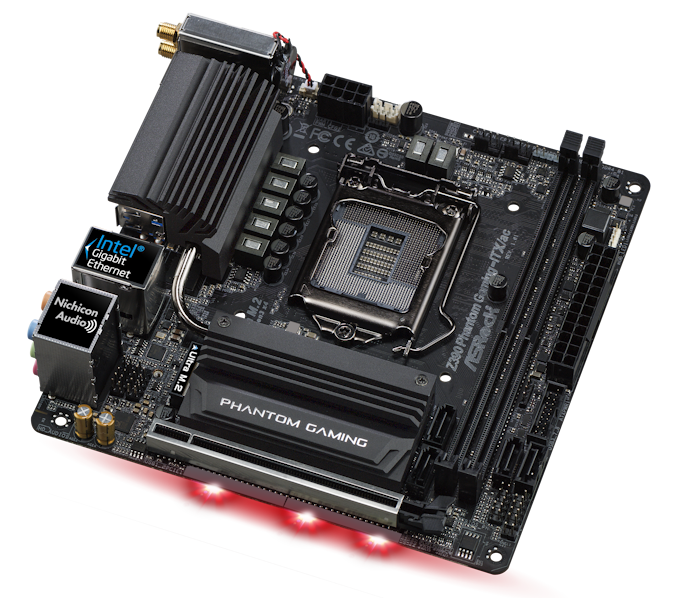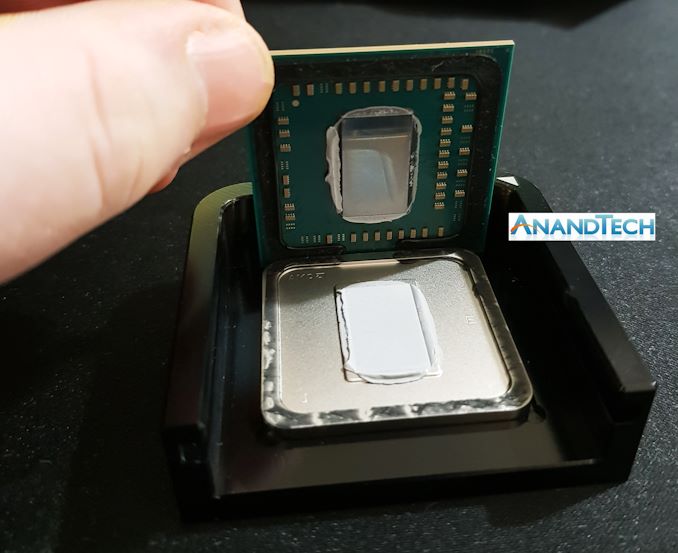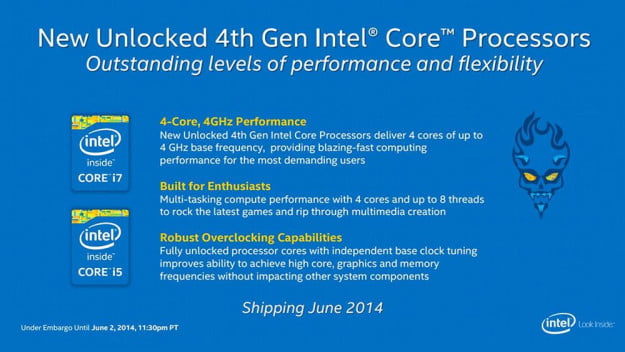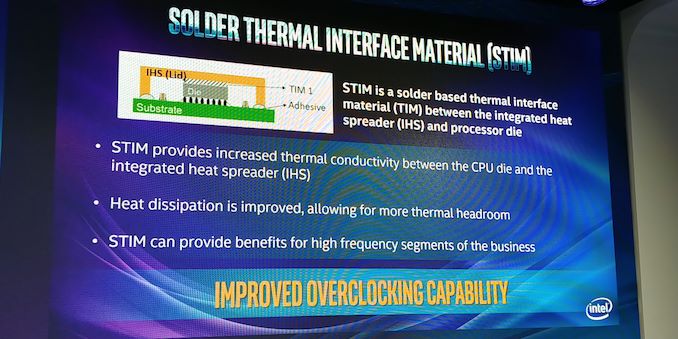The Intel 9th Gen Review: Core i9-9900K, Core i7-9700K and Core i5-9600K Tested
by Ian Cutress on October 19, 2018 9:00 AM EST- Posted in
- CPUs
- Intel
- Coffee Lake
- 14++
- Core 9th Gen
- Core-S
- i9-9900K
- i7-9700K
- i5-9600K
Hardware and Software Security Fixes
The Spectre and Meltdown vulnerabilities made quite a splash earlier this year, forcing makers of hardware and software to release updates in order to tackle them. There are several ways to fix the issues, including software, firmware, and hardware updates. Each generation of product is slowly implementing fixes, including some of the new 9th Generation processors.
At this point Intel has split the list down into 5/6 wide variants of different types of vulnerabilities. For all processors beyond mid-2018, here is what the fix table looks like:
| Spectre and Meltdown on Intel | |||||||
| AnandTech | SKX-R 3175X |
CFL-R | Cascade Lake | Whiskey Lake |
Amber Lake |
||
| Spectre | Variant 1 | Bounds Check Bypass | OS/VMM | OS/VMM | OS/VMM | OS/VMM | OS/VMM |
| Spectre | Variant 2 | Branch Target Injection | Firmware + OS | Firmware + OS | Hardware + OS | Firmware + OS | Firmware + OS |
| Meltdown | Variant 3 | Rogue Data Cache Load | Firmware | Hardware | Hardware | Hardware | Firmware |
| Meltdown | Variant 3a | Rogue System Register Read | Firmware | Firmware | Firmware | Firmware | Firmware |
| Variant 4 | Speculative Store Bypass | Firmware + OS | Firmware + OS | Firmware + OS | Firmware + OS | Firmware + OS | |
| Variant 5 | L1 Terminal Fault | Firmware | Hardware | Hardware | Hardware | Firmware | |
The new 9th Generation processors, listed as CFL-R (Coffee Lake Refresh), has implemented hardware fixes for variant 3, Rogue Data Cache Load, and variant 5, L1 Terminal Fault.
Because the new chips have required new masks for manufacturing, Intel has been able to make these changes. The goal of moving the changes into hardware means that the hardware is always protected, regardless of OS or environment, and with the hope that any additional overhead created by a software fix can be lessened if done in hardware.
(S)TIM: Soldered Down Processors
With the desktop processors we use today, they are built from a silicon die (the smart bit), a package substrate (the green bit), a heatspreader (the silver bit), and a material that helps transfer heat from the silicon die to the heatspreader. The quality of the binding between the silicon die and the heatspreader using this thermal interface material is a key component in the processors ability to remove the heat generated from using it.
Traditionally there are two different types of thermal material: a heat conductive paste, or a bonded metal. Both have positives and negatives.
The heat conductive paste is a universal tool – it can be applied to practically any manufactured processor, and is able to deal with a wide range of changing conditions. Because metals expand under temperature, when a processor is used and gets hot, it expands – so does the heatspreader. The paste can easily deal with this. This allows paste-based processors to live longer and in more environments. Using a bonded metal typically reduces the level of thermal cycling possible, as the metal also expands and contracts in a non-fluid way. This might mean the processors has a rated lifespan of several years, rather than a dozen years. However, the bonded metal solution performs a lot, lot better – metal conducts heat better than the silicon-based pastes – but it is slightly more expensive (a dollar or two per unit, at most, when the materials and manufacturing are taken into account).
| Thermal Interface | |||||||
| Intel | Celeron | Pentium | Core i3 | Core i5 | Core i7 Core i9 |
HEDT | |
| Sandy Bridge | LGA1155 | Paste | Paste | Paste | Bonded | Bonded | Bonded |
| Ivy Bridge | LGA1155 | Paste | Paste | Paste | Paste | Paste | Bonded |
| Haswell / DK | LGA1150 | Paste | Paste | Paste | Paste | Paste | Bonded |
| Broadwell | LGA1150 | Paste | Paste | Paste | Paste | Paste | Bonded |
| Skylake | LGA1151 | Paste | Paste | Paste | Paste | Paste | Paste |
| Kaby Lake | LGA1151 | Paste | Paste | Paste | Paste | Paste | - |
| Coffee Lake | 1151 v2 | Paste | Paste | Paste | Paste | Paste | - |
| CFL-R | 1151 v2 | ? | ? | ? | K = Bonded | - | |
| AMD | |||||||
| Zambezi | AM3+ | Bonded | Carrizo | AM4 | Bonded | ||
| Vishera | AM3+ | Bonded | Bristol R | AM4 | Bonded | ||
| Llano | FM1 | Paste | Summit R | AM4 | Bonded | ||
| Trinity | FM2 | Paste | Raven R | AM4 | Paste | ||
| Richland | FM2 | Paste | Pinnacle | AM4 | Bonded | ||
| Kaveri | FM2+ | Paste / Bonded* | TR | TR4 | Bonded | ||
| Carrizo | FM2+ | Paste | TR2 | TR4 | Bonded | ||
| Kabini | AM1 | Paste | |||||
| *Some Kaveri Refresh were bonded | |||||||
In our Ryzen APU delidding article, we went through the process of removing the heatspreader and conductive paste from a popular low cost product, and we showed that replacing that paste with a bonded liquid metal improved temperatures, overclocking, and performance in mid-range overclocks. If any company wants to make enthusiasts happy, using a bonded metal is the way to go.
For several years, Intel has always stated that they are there for enthusiasts. In the distant past, as the table above shows, Intel provided processors with a soldered bonded metal interface and was happy to do so. In recent times however, the whole product line was pushed into the heat conductive paste for a number of reasons.
As Intel was continually saying that they still cared about enthusiasts, a number of users were concerned that Intel was getting itself confused. Some believed that Intel had ‘enthusiasts’ and ‘overclockers’ in two distinct non-overlapping categories. It is what it is, but now Intel has returned to using applying STIM and wants to court overclockers again.
Intel has officially confirmed that new 9th generation processors will feature a layer of solder making up the TIM between the die and the IHS. The new processors with solder include the Core i9-9900K, the Core i7-9700K and Core i5-9600K.
As we’ll show in this review, the combination of STIM plus other features are of great assistance when pushing the new processors to the overclocking limits. Intel’s own overclocking team at the launch event hit 6.9 GHz temporarily using exotic sub-zero coolants such as liquid nitrogen.
Motherboards and the Z390 Chipset
One of the worst kept secrets this year has been Intel’s Z390 chipset. If you believe everything the motherboard manufacturers have told me, most of them had been ready for this release for several months, hence why seeing around 55 new motherboards hit the market this month and into next.
The Z390 chipset is an update to Z370, and both types of motherboards will support 8000-series and 9000-series processors (Z370 will need a BIOS update). The updates are similar to the updates seen with B360: native USB 3.1 10 Gbps ports, and integrated Wi-Fi on the chipset.
| Intel Z390, Z370 and Z270 Chipset Comparison | |||
| Feature | Z390 | Z370 | Z270 |
| Max PCH PCIe 3.0 Lanes | 24 | 24 | 24 |
| Max USB 3.1 (Gen2/Gen1) | 6/10 | 0/10 | 0/10 |
| Total USB | 14 | 14 | 14 |
| Max SATA Ports | 6 | 6 | 6 |
| PCIe Config | x16 x8/x8 x8/x4/x4 |
x16 x8/x8 x8/x4/x4 |
x16 x8/x8 x8/x4/x4 |
| Memory Channels | 2 | 2 | 2 |
| Intel Optane Memory Support | Y | Y | Y |
| Intel Rapid Storage Technology (RST) | Y | Y | Y |
| Max Rapid Storage Technology Ports | 3 | 3 | 3 |
| Integrated 802.11ac WiFi MAC | Y | N | N |
| Intel Smart Sound | Y | Y | Y |
| Integrated SDXC (SDA 3.0) Support | Y | N | N |
| DMI | 3.0 | 3.0 | 3.0 |
| Overclocking Support | Y | Y | Y |
| Intel vPro | N | N | N |
| Max HSIO Lanes | 30 | 30 | 30 |
| Intel Smart Sound | Y | Y | Y |
| ME Firmware | 12 | 11 | 11 |
The integrated Wi-Fi uses CNVi, which allows the motherboard manufacturer to use one of Intel’s three companion RF modules as a PHY, rather than using a potentially more expensive MAC+PHY combo from a different vendor (such as Broadcom). I have been told that the cost of implementing a CRF adds about $15 to the retail price of the board, so we are likely to see some vendors experiment with mid-price models with-and-without Wi-Fi using this method.

ASRock Z390 Phantom Gaming-ITX/ac
For the USB 3.1 Gen 2 ports, Type-A ports are supported natively and motherboard manufacturers will have to use re-driver chips to support Type-C reversibility. These come at extra cost, as one might expect. It will be interesting to see how manufacturers mix and match the Gen 2, Gen 1, and USB 2.0 ports on the rear panels, now they have a choice. I suspect it will come down to signal integrity on the traces on the motherboard.
For the Z390 chipset and motherboards, we have our usual every-board-overview post, covering every model the manufacturers would tell us about. Interestingly there is going to be a mini-ITX with Thunderbolt 3, and one board with a PLX chip! There are also some motherboards with Realtek’s 2.5G Ethernet controller – now if only we also had consumer grade switches.















274 Comments
View All Comments
eastcoast_pete - Sunday, October 21, 2018 - link
Yes; unfortunately, that's a major exception, and annoying to somebody like me who'd actually recommend AMD otherwise. I really hope that AMD improves it's AVX/AVX2 implementation and makes it truly 256 bit wide. If I remember correctly, the lag of Ryzen chips in 256 bit AVX vs. Intel is due to AMD using a 2 x 128 bit implementation (workaround, really), which is just nowhere near as fast as real 256 bit AVX. So, I hope that AMD gives their next Ryzen generation full 256 bit AVX, not the 2 x 128 bit workaround.mapesdhs - Sunday, October 21, 2018 - link
It's actually worse than that with pro apps. Even if AMD hugely improved their AVX, it won't help as much as it could so long as apps like Premiere remain so poorly coded. AE even has plugins that are still single-threaded from more than a decade ago. There are also several CAD apps that only use a single core. I once sold a 5GHz 2700K system to an engineering company for use with Majix, it absolutely blew the socks off their far more expensive XEON system (another largely single-threaded app, though not entirely IIRC).Makes me wonder what they're teaching sw engineering students these days; parallel coding and design concepts (hw and sw) was a large part of the comp sci stuff I did 25 years ago. Has it fallen out of favour because there aren't skilled lectures to teach it? Or students don't like tackling the hard stuff? Bot of both? Some of it was certainly difficult to grasp at first, but even back then there was a lot of emphasis on multi-threaded systems, or systems that consisted of multiple separate functional units governed by some kind of management engine (not unlike a modern game I suppose), at the time coding emphasis being on derivatives of C++. It's bizarre that after so long, Premiere inparticular is still so inefficient, ditto AE. One wonders if companies like Adobe simply rely on improving hw trends to provide customers with performance gains, instead of improving the code, though this would fly in the face of their claim a couple of years ago that they would spend a whole year focusing on improving performance since that's what users wanted more than anything else (I remember the survey results being discussed on creativcow).
eastcoast_pete - Sunday, October 21, 2018 - link
Fully agree! Part of the problem is that the re-coding single-thread routines that could really benefit from parallel/multi-thread execution costs the Adobes of this world money, especially if one wants it done right. However, I believe that the biggest reason why so many programs, in full or in part, are solidly stuck in the last century is that their customers simply don't know what they are missing out on. Once volume licensees start asking their software supplier's sales engineers (i.e. sales people) "Yes, nice new interface. But, does this version now fully support multithreaded execution, and, if not, why not?", Adobe and others will give this the priority it should have had all along.repoman27 - Friday, October 19, 2018 - link
USB Type-C ports don't necessarily require a re-timer or re-driver (especially if they’re only using Gen 1 5 Gbit/s signaling), but they do require a USB Type-C Port Controller.The function of that chip is rather different though. Its job is to utilize the CC pins to perform device attach / detach detection, plug orientation detection, establish the initial power and data roles, and advertise available USB Type-C current levels. The port controller also generally includes a high-speed mux to steer the SuperSpeed signals to whichever pins are being used depending on the plug orientation. Referring to a USB Type-C Port Controller as a re-driver is both inaccurate and confusing to readers.
willis936 - Friday, October 19, 2018 - link
Holy damn that's a lot of juice. 220W? That's 60 watts more than a 14x3GHz core IVB E5.They had better top charts with that kind of power draw. I have serious reservations about believing two DDR4 memory channels is enough to feed 8x5GHz cores. I would be interested in a study of memory scaling on this chip specifically, since it's the corner case for the question "Is two memory channels enough in 2018?".
DominionSeraph - Friday, October 19, 2018 - link
This chip would be faster in everything than a 14 core IVB E5, while being over 50% faster in single-threaded tasks.Also, Intel is VERY generous with voltage in turbo. Note the 9700K at stock takes 156W in Blender for a time of 305, but when they dialed it in at 1.025V at 4.6GHz it took 87W for an improved time of 301, and they don't hit the stock wattage until they've hit 5.2GHz. When they get the 9900K scores up I expect that 220W number to be cut nearly in half by a proper voltage setting.
3dGfx - Friday, October 19, 2018 - link
How can you claim 9900k is the best when you never tested the HEDT parts in gaming? Making such claims really makes anandtech look bad. I hope you fix this oversight so skyX can be compared properly to 9900K and the skyX refresh parts!!! -- There was supposed to be a part2 to the i9-7980XE review and it never happened, so gaming benchmarks were never done, and i9-7940X and i9-7920X weren't tested either. HEDT is a gaming platform since it has no ECC support and isn't marketed as a workstation platform. Curious that intel says the 8-core part is now "the best" and you just go along with that without testing their flagship HEDT in games.DannyH246 - Friday, October 19, 2018 - link
If you want an unbiased review go here...https://www.extremetech.com/computing/279165-intel...
Anandtech is a joke. Has been for years. Everyone knows it.
TEAMSWITCHER - Friday, October 19, 2018 - link
Thanks... but no thanks. Why did you even come here? Just to post this? WEAK!Arbie - Friday, October 19, 2018 - link
What a stupid remark. And BTW Extremetech's conclusion is practically the same as AT's. The bias here is yours.